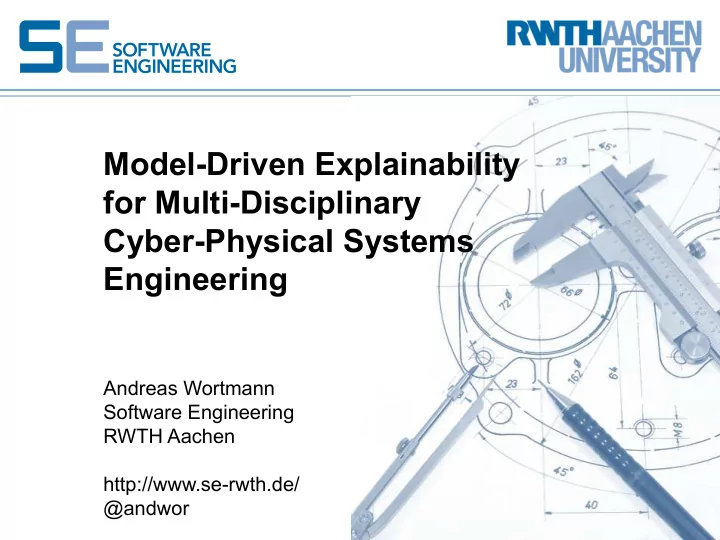

Model-Driven Explainability for Multi-Disciplinary Cyber-Physical Systems Engineering Andreas Wortmann Software Engineering RWTH Aachen http://www.se-rwth.de/ @andwor
Andreas Wortmann Software Engineering About me RWTH Aachen Slide 2 Since 2011 working with robotics § • knowledge-based (Golog, …) • imperative (ROS, SmartSoft) • educational & industrial § PhD’16 on extensible ADLs for CPS § Currently work in model-driven systems engineering § Language-oriented systems engineering • build proper software languages efficiently • tailor, reuse, integrate existing languages • across different technological spaces http://www.se-rwth.de/teams/mdse/
Andreas Wortmann Software Engineering The sad state of software explainability RWTH Aachen Slide 3 Stack traces too technical for many purposes § § Log files too verbose, not abstract enough, not reader-specific
Andreas Wortmann Software Engineering Energy Mechanical RWTH Aachen Efficiency Structure Slide 4 Human- Machine Software Interaction Integration Active Object Thermal Recognition Insulation Propulsion Safety System Regulations Communications Legislation Navigation insprired by @bcombemale
Andreas Wortmann Software language engineering gives us better tools Software Engineering RWTH Aachen to explicate intent and purpose than pure code Slide 5 § ”The limits of my language are the limits of my world” (Wittgenstein) Stakeholders of CPS speak different languages § and give explanations in different languages Ø so do their software modules § Understanding emergent system behavior requires understanding all related modules In a way that supports § • reasoning about facts (what) • contrasting observations (why) • Enquiring intentions (how) § Suitable modeling languages can support CPS explainability at run time and at design-time
Andreas Wortmann Towards explanation languages for multi-disciplinary Software Engineering RWTH Aachen cyber-physical systems Slide 6 § Modeling languages that describe explanation (parts) • to explain behavior based on lower level facts and explanations (F&E) § Either general (e.g., ATL) or domain-specific explanation languages 1 • former better integratable, latter better accessible, demand integration § Systems produce histories = ordered lists of F&Es in suitable languages § F&E yield meta information (source, purpose) to reason about system behavior ( e.g., “show all crash-related info but abstract from battery” ) § Such explanation should be • receiver-specific (propulsion expert no interest in HMI explanation parts) • message-specific (e.g., by giving meaning stack trace segments) • time-specific (e.g., truncate irrelevant explanation parts) § Across models of different domains § Throughout the complete system lifecycle 1 K. Hölldobler, B. Rumpe, A. Wortmann. Software Language Engineering in the Large: Towards Composing and Deriving Languages. In: Computer Languages, Systems & Structures, 54, 2018.
Andreas Wortmann A 2D component model to explain the behavior of a Software Engineering RWTH Aachen package delivery quadcopter Slide 7 Systems engineering leverages component-based notions § Explanations as 1 st level concerns in component (meta) model § Extensible metamodel for explanations Quadcopter Architecture History Mission Control Obst. deliberatively Navigation Episode Det. starts new episodes Motor Motor Motor Motor Cam 01 02 03 04 Role Fact Source Time conclusion premise 2D Component Model Explanation processable facts and explanations § Architecture supports operating on F&E Navigation required provided § Metamodel supports tailoring to services services domain-specific F&E provided facts and explanations
Andreas Wortmann A 2D component model to explain the behavior of a Software Engineering RWTH Aachen package delivery quadcopter Slide 8 Domain-specific instantiation of the quadcopter explanation § language (e.g., language embedding 1 or merging 2 ) new DSL History NaviFact NoRoute Episode ObstDFact NoFlyZone Object conclusion Role Fact Source premise Recogniti conclusion Time premise on Navigatio n Explanation NaviExplanation premise MCExplanation conclusion MCFact DeliveryImpossible 1 K. Hölldobler, B. Rumpe, A. Wortmann. Software Language Engineering in the Large: Towards Composing and Deriving Languages. In: Computer Languages, Systems & Structures, 54, 2018. 2 Degueule, T., Combemale, B., Blouin, A., Barais, O., & Jézéquel, J. M. Melange: A meta-language for modular and reusable development of DSLs. In Proceedings of the 2015 SLE. 2015.
Andreas Wortmann There are many challenges in explainable software Software Engineering RWTH Aachen for cyber-physical systems… Slide 9 Capturing and integrating facts & explanations of different domains § § Efficient adaptation between F&E of different components • normal system integration activity? Automatically deriving explanations § § A posteriori explainer integration into existing (legacy) systems § Automated abstraction and history truncation of explanations Cooperative / partial explanations § … to achieve any of these, we first need explicit explanations
Andreas Wortmann Software Engineering Our answers to workshop-related questions RWTH Aachen Slide 10 ES4CPS problems that we are interested in § • making explanations explicit • leveraging explicit explanations at run time • querying explanations (facts, contrasts, …) ES4CPS expertise that we can contribute § • modular software language engineering • smart manufacturing, automotive software testing, robotics • formal systems modeling (focus, mona, isabelle) External expertise that we need § • domain-specific insights into explanations • multi-disciplinary modeling • reasoning about explanations
Andreas Wortmann Software Engineering Thank You RWTH Aachen Slide 11 Twitter Publications Videos @andwor wortmann.ac wortmann.ac/videos
Recommend
More recommend